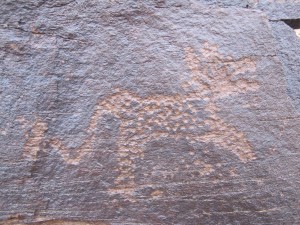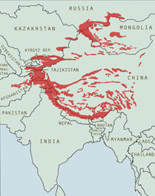
A closeup of a detailed snow leopard rock carving from the Iron Age in Upper Tibet. We can clearly see the rosettes or spots of the cat. Copyright John Vincent Bellezza.
Petroglyphs are rock carvings made by many different cultures around the world since ancient times. People would use sharp stones and other tools to carve drawings into stone to record events and their world. The word comes from the Greek ‘petros’, meaning stone and the word ‘glyphein’, meaning to carve.
John Vincent Bellezza is Senior Research Fellow at the Tibet Center, University of Virginia, and Charlotteville, Virginia. A highly esteemed scholar and explorer, John has spent more than two decades studying Zhang Zhung, the ancient culture of western and northwestern Tibet, which was associated with the Bon religion, before the introduction of Buddhism.

John Bellezza has spent many years on painstaking research surveying rock art in Tibet. Copyright John Vincent Bellezza.
His studies included researching petroglyphs in remote mountain ruins and rock outcrops. One day he found these enchanting carvings. We can only surmise who would have made them and why but today they speak to us across thousands of years telling a story, a myth or a legend of snow leopards that some-one, all those years ago, felt was important.
I was in touch with John a few months ago and he’s very kindly agreed to share his snow leopard petroglyph photos with readers of Saving Snow Leopard Blog.
“These snow leopard petroglyhps were found in Uppper Tibet and they date from prehistoric times, probably the Iron Age (around the 10th to 7th century BCE).
One is a lovely close up of a snow leopard and the other a snow leopard with gaping jaws in pursuit of two wild ungulates (sheep or goats), with a crescent moon as well. We might surmise that this petroglyph depicts a dawn or dusk hunting scene, given the relative position of the moon.

Photo of a snow leopard rock carving from iron Age Upper Tibet. Copyright John Vincent Bellezza.
In Tibetan the snow leopard is called sa’u. It is the undisputed king of the alpine and aeolian biomes of Tibet. (Aeolian biomes are the zone of the highest life, a zone based on atmospheric nutrients, a zone of the wind as first described by L. W. Swan). The snow leopard is noted in Tibetan ritual literature as belonging to the entourage of important mountain gods. These ancestral and protective deities are said to keep fierce carnivores such as the wolf, brown bear and the snow leopard like ordinary mortals keep sheep and goats. The oldest cultural record for the snow leopard is found in Upper Tibet, a land of vast plains crisscrossed by lofty mountain ranges that run perpendicular to the Himalayan Range. This is the rock art record, prehistoric carvings in stone of snow leopards. It is not clear if these depictions of solitary snow leopards represent biological or numinous (that is the spiritual) forms of the animal. Perhaps this great carnivore was rendered in both guises.”

A petroglyph, this one a large wild sheep with huge horns carved 2000 years ago on rock in Altai, southern Russia. Photo Sibylle Noras.
Thanks very much for sharing these John. During my 2010 snow leopard trip to Altai in Russia I became interested in petroglyphs after seeing many rock carvings on the steppe near Koch Agash where we were researching snow leopard habitat. I found lots of ibex (wild goat) petroglyphs but sadly no snow leopards. Kyrgyzstan has petroglyphs of snow leopards too, at the Issyk Kul Open Air museum in Cholpon Ata and there’s a very special rock with an image of a tamed snow leopard used by nomads in a hunt much like ancient Egyptians used to use tame cheetah. Amazing!
John’s two latest volumes, Antiquities of Zhang Zhung, have just been published and are online at www.thlib.org/bellezza.




{ 0 comments… add one }